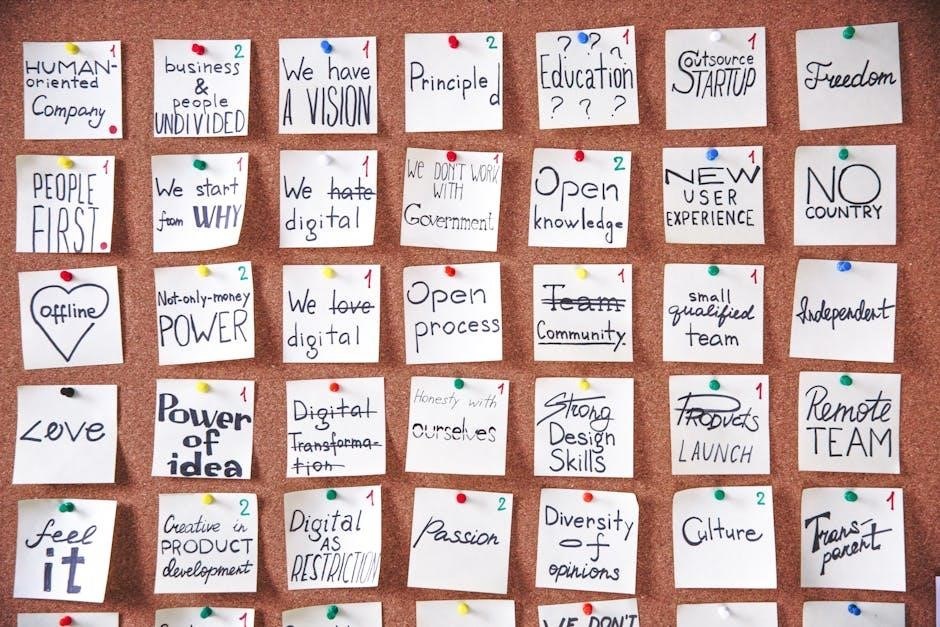Sight words are high-frequency words essential for early reading skills. They are called Dolch words and appear frequently in texts. Mastering these words improves reading fluency and comprehension, making them a foundation for young learners. Worksheets provide engaging exercises to practice and memorize these words, ensuring a strong reading base for Grade 1 students.
1.1 What Are Sight Words?
Sight words, also known as high-frequency words, are common words that appear frequently in texts. They are often irregular and don’t follow phonetic rules, making them difficult to sound out. These words, including examples like the, is, and and, are crucial for reading fluency and comprehension. Sight words are categorized by grade levels, with specific lists for each grade, such as Grade 1 Dolch words. Mastering these words allows young readers to recognize them instantly, enhancing their reading skills. Worksheets and activities are designed to help students memorize and practice these words through exercises like tracing, matching, and fill-in-the-blank tasks, making learning engaging and effective.
1.2 Importance of Sight Words in Reading Development
Sight words play a vital role in reading development as they are the foundation of fluent reading. These high-frequency words, often irregular and non-phonetic, are encountered repeatedly in texts, making memorization essential for quick recognition. When students master sight words, they can focus on comprehension rather than decoding, improving reading fluency. This ability to read effortlessly enhances their confidence and enjoyment of reading. Sight words also form the building blocks for more complex reading skills, such as vocabulary expansion and sentence structure understanding. By prioritizing sight word practice, educators and parents help students develop strong reading habits and a smoother transition to advanced literacy.
1.3 Grade 1 Sight Words List
The Grade 1 sight words list includes high-frequency words that are essential for early reading development. Examples of these words include a, and, are, as, at, be, but, by, for, from, have, he, in, is, it, no, of, on, that, the, to, was, was, with, and more. These words are chosen because they appear frequently in texts but often don’t follow phonetic rules. Mastering this list helps students recognize words instantly, improving reading fluency and comprehension. Sight words worksheets for Grade 1 often focus on these specific words, making practice fun and engaging for young learners. Regular practice ensures a strong foundation for future reading skills.

Benefits of Using Sight Words Worksheets
Sight words worksheets improve reading fluency, enhance recognition, and build confidence in young readers. They also reduce decoding anxiety and foster a love for reading.
2.1 Improving Reading Fluency
Sight words worksheets play a key role in enhancing reading fluency among Grade 1 students. By repeatedly practicing high-frequency words, children develop the ability to recognize them instantly, reducing the need for decoding. This automatic recognition allows young readers to focus on comprehension and expression, making their reading smoother and more natural. Worksheets designed for sight words often include activities that promote memorization and repetition, such as tracing, matching, and fill-in-the-blank exercises. These tools help students build confidence and accuracy, enabling them to read with greater speed and precision. Regular practice with sight words worksheets laying a strong foundation for fluent reading skills.
2.2 Enhancing Sight Word Recognition
Sight words worksheets are invaluable for improving sight word recognition in Grade 1 students. These exercises expose children to high-frequency words in a structured format, helping them commit the words to memory. Through repetitive practice, students develop the ability to recognize these words instantly, without sounding them out. Worksheets often feature activities like matching games, tracing, and fill-in-the-blank exercises, which reinforce visual memory and word association. This focused practice ensures that students can identify sight words quickly and accurately, building a strong foundation for reading proficiency. Regular use of these worksheets strengthens their ability to recognize and read sight words with confidence and ease.
2.3 Building Confidence in Young Readers
Sight words worksheets play a significant role in building confidence in young readers; By mastering these high-frequency words, children gain a sense of accomplishment and pride in their reading abilities. Worksheets provide a structured and repetitive format, allowing students to practice and reinforce their skills in a non-threatening environment. As they progress and recognize more words, their self-esteem grows, encouraging them to take on more challenging reading tasks. The immediate feedback from completing worksheets also helps students feel a sense of achievement, fostering a positive attitude toward learning and reading. This confidence boost is essential for developing lifelong reading skills and a love for literature.

Types of Sight Words Worksheets for Grade 1

Various types of sight words worksheets for Grade 1 include tracing, matching, fill-in-the-blank, and word hunt activities, designed to engage young learners and make practice enjoyable and effective.

3.1 Tracing Worksheets
Tracing worksheets are an excellent way to help Grade 1 students practice sight words. These worksheets typically feature large, bold letters for children to trace, helping them develop muscle memory and improve handwriting. Many PDF resources include tracing exercises with arrows or dotted lines to guide little hands. By repeatedly tracing sight words, students build familiarity and confidence. These worksheets often include space for children to write the words independently after tracing, reinforcing their ability to recognize and spell the words correctly. Tracing activities are particularly beneficial for young learners, as they combine motor skills practice with early reading development. They are simple yet effective tools for mastering sight words.
3.2 Matching Games
Matching games are interactive and engaging sight word activities for Grade 1 students. These worksheets often feature word cards or lists that children match to corresponding pictures, sentences, or identical words. For example, students might pair the word “cat” with a picture of a cat or match sight words to their meanings. Matching games improve recognition, memory, and reading fluency in a fun way. Many PDF resources include colorful and themed matching activities to keep young learners excited. These exercises also enhance fine motor skills as children cut, sort, and paste words. Matching games are versatile and can be adapted to different learning styles, making them a valuable tool for sight word practice.
3.3 Fill-in-the-Blank Exercises
Fill-in-the-blank exercises are a highly effective way to practice sight words for Grade 1 students. These worksheets typically provide sentences with missing words, which children complete by selecting the correct sight word from a word bank or memory. This activity strengthens vocabulary, spelling, and comprehension skills. Fill-in-the-blank exercises also help students understand word context and sentence structure. Many PDF resources offer themed exercises, such as holiday-themed or animal-themed worksheets, to keep learning engaging. By repeatedly practicing these exercises, students build confidence and improve their ability to recognize and use sight words in meaningful ways. This method is both educational and entertaining for young learners.
3.4 Word Hunts and Scavenger Activities
Word hunts and scavenger activities are engaging ways to practice sight words with Grade 1 students. These exercises involve searching for words in word grids or within sentences, fostering active participation and excitement. Scavenger hunts can be conducted in various formats, such as finding words in a word search puzzle or locating them in short stories. These activities enhance sight word recognition, improve focus, and make learning fun. Many PDF worksheets include themed word hunts, such as seasonal or animal-themed grids, to keep students interested. By incorporating movement and exploration, these activities cater to kinesthetic learners and create a dynamic learning experience.

How to Use Sight Words Worksheets Effectively
Incorporate worksheets into daily routines, use interactive activities, and provide feedback. Ensure practice is consistent, engaging, and tailored to Grade 1 students’ developmental needs for optimal results.
4.1 Incorporating Worksheets into Daily Practice
Incorporating sight words worksheets into daily practice helps Grade 1 students build consistency and familiarity with high-frequency words. Start with short, manageable sessions of 5-10 minutes to avoid overwhelm. Use a variety of worksheet types, such as tracing, matching, or fill-in-the-blank exercises, to keep learning engaging. Ensure the worksheets align with the child’s current skill level and gradually increase difficulty as they progress. Consistency is key, so establish a regular routine, such as completing a worksheet during homework time or right after reading practice. This daily exposure reinforces memory retention and strengthens reading fluency over time. Positive reinforcement and praise will also motivate young learners to stay committed to their practice.
4.2 Making Learning Fun with Interactive Activities
Making learning fun with interactive activities is essential for engaging Grade 1 students with sight words. Transform worksheets into games like bingo or scavenger hunts, where children search for sight words in sentences or stories. Use flashcards for quick recognition drills, or incorporate technology with educational apps that offer interactive sight word exercises. Reward systems, such as stickers or stars, can motivate students to participate eagerly. Pairing sight words with movements or songs adds a playful element, helping children associate learning with enjoyment. These activities not only enhance retention but also foster a positive attitude toward reading and learning.
4.3 Tracking Progress and Providing Feedback
Tracking progress and providing feedback are crucial for helping Grade 1 students master sight words. Use worksheets to monitor accuracy and speed over time, identifying areas where a child may struggle. Regularly review completed exercises to assess improvement and adjust practice accordingly. Provide immediate feedback by highlighting correct answers and gently correcting mistakes. Celebrate small victories to boost motivation, while offering specific guidance for challenging words. Maintaining a progress chart or journal can help visualize growth and encourage consistent effort. This structured approach ensures learners stay on track and feel supported throughout their sight word journey.

Popular Resources for Sight Words Worksheets
Discover popular resources for Grade 1 sight words worksheets, including free printable worksheets, educational websites, and teacher-created materials designed to support young learners effectively.
5.1 Free Printable Worksheets Online
Access a wide range of free printable sight words worksheets for Grade 1 online. Websites like Education.com and Teachers Pay Teachers offer extensive collections of downloadable PDFs. These worksheets include activities such as tracing, matching, and fill-in-the-blank exercises tailored for young learners. Many resources are specifically designed to align with Grade 1 curricula, ensuring relevance and effectiveness. Popular options also include word cards, bingo games, and flashcards. These worksheets are ideal for parents and educators seeking affordable, high-quality materials to support sight word mastery. They are easy to print and require minimal preparation, making them a convenient choice for daily practice.
- Education.com: Offers themed worksheets and interactive activities.
- Teachers Pay Teachers: Provides teacher-curated resources for diverse learning needs.
- Worksheetfun and SightWords.com: Specialize in sight word exercises with creative layouts.
These free resources are perfect for reinforcing sight word recognition in a fun and engaging way, helping students build a strong reading foundation.
5.2 Paid Resources and Educational Websites
For more comprehensive tools, consider investing in paid resources and educational websites that specialize in sight words. Platforms like Reading A-Z and ABCmouse offer extensive libraries of Grade 1 sight words worksheets in PDF format. These resources often include interactive activities, printable games, and progress-tracking features. All About Reading provides structured programs with sight word practice integrated into larger reading lessons. Paid subscriptions typically offer higher quality, organization, and customization options, making them valuable for dedicated practice. These resources are ideal for educators and parents seeking robust materials to enhance learning outcomes.
- Reading A-Z: Access leveled books and supplementary worksheets.
- ABCmouse: Engage with interactive sight word games and activities.
- All About Reading: benefit from comprehensive reading programs with sight word focus.
These paid resources are designed to provide structured and engaging sight word practice for Grade 1 students, supporting their reading development effectively.

5.3 Teacher-Created Materials
Many teachers design their own sight words worksheets for Grade 1 to cater to specific classroom needs. These materials are often shared on platforms like Teachers Pay Teachers or Pinterest, offering unique and engaging activities. Teacher-created worksheets are frequently tailored to align with curriculum standards and incorporate fun themes or images to capture students’ interest. They may include games, puzzles, or interactive exercises that make learning sight words enjoyable. These resources are highly adaptable, allowing teachers to customize them for individual or group use. By leveraging their classroom experience, educators create materials that are both effective and relevant, ensuring students stay motivated and focused during practice.
- Customizable worksheets to match teaching styles.
- Incorporation of fun themes to engage young learners.
- Adaptability for individual or group activities.
Teacher-created materials are a valuable resource for making sight word practice both effective and enjoyable for Grade 1 students.
Tips for Parents and Teachers
Encourage daily practice, create a supportive environment, and use interactive methods to make learning sight words enjoyable. Provide feedback and celebrate progress to build confidence.
6.1 Creating a Conducive Learning Environment
Establish a quiet, distraction-free space for learning sight words. Ensure good lighting and comfortable seating to promote focus. Organize materials, such as sight words worksheets, flashcards, and posters, within easy reach. Display charts or word walls with high-frequency words to reinforce recognition; Incorporate interactive elements like word cards or games to make the environment engaging. Encourage a positive atmosphere by praising efforts and celebrating small achievements. Rotate activities to maintain interest and prevent boredom. Use visual aids and hands-on tools to cater to different learning styles. Regularly update the space with new words and resources to keep the learning process dynamic and effective.
6.2 Encouraging Repetition and Practice
Repetition is key to mastering sight words. Encourage daily practice using worksheets, flashcards, or interactive games. Set aside a specific time each day for consistent review. Use sight words worksheets to reinforce recognition and spelling. Incorporate activities like writing words in sand, tracing with fingers, or using letter tiles to make practice engaging. Celebrate progress, no matter how small, to build motivation. Provide immediate feedback to correct mistakes and reinforce learning. Over time, gradually increase the number of words as confidence and fluency grow. Repetition strengthens memory and ensures long-term retention of sight words.
6.3 Incorporating Technology for Interactive Learning
Incorporating technology into sight words practice can make learning engaging and fun for Grade 1 students; Educational apps like Teach Your Monster to Read and Sight Words Pro offer interactive games and exercises. Online platforms such as ABCmouse and Starfall provide digital worksheets and activities that align with sight words curriculum. Interactive whiteboards in classrooms can also be used for tracing and matching games. Additionally, QR code scavenger hunts linking to sight word videos or audio can make practice exciting. Technology enhances learning by providing varied and dynamic experiences, helping students build fluency and confidence in a modern and accessible way.

Assessing Sight Word Mastery
Assess sight word mastery using worksheets as quizzes, flashcards, or reading passages. Track progress over time to identify improvements and areas needing review. Digital tools like apps and games can also measure fluency and accuracy, providing instant feedback. Regular assessments help teachers and parents understand a child’s grasp of sight words, ensuring they are ready for advanced reading skills. Monitoring progress builds confidence and highlights achievements, keeping learners motivated and focused on their goals.
7.1 Using Worksheets as Assessment Tools
Sight words worksheets are invaluable for assessing mastery in Grade 1 students. They can be designed as short quizzes or flashcards to test recognition and recall. Incorporating fill-in-the-blank exercises or reading passages with missing sight words helps evaluate fluency and understanding. Scoring these worksheets provides measurable data on accuracy and speed, identifying gaps in knowledge. Teachers and parents can use these assessments to track progress over time, ensuring students meet benchmarks. Regular use of worksheets as assessment tools fosters accountability and targeted practice, helping learners solidify their sight word skills effectively. This approach ensures a clear understanding of their readiness for more complex reading tasks.
7.2 Identifying Areas for Further Practice
Sight words worksheets are excellent for pinpointing areas where Grade 1 students need extra practice. By reviewing completed worksheets, teachers and parents can identify which sight words are consistently missed or hesitated over. This targeted feedback helps focus additional practice on specific words or patterns. For example, if a student frequently struggles with words like “the” or “was,” extra drills or games can be tailored to reinforce these. Regular analysis of worksheet results ensures that learning gaps are addressed promptly, allowing for more effective and personalized instruction. This focused approach maximizes progress and builds a stronger foundation in sight word recognition.

7.3 Celebrating Progress and Success
Celebrating progress and success is crucial for motivating young learners when using sight words worksheets. Recognizing milestones, such as mastering a set of words or improving accuracy, boosts confidence and enthusiasm. Teachers and parents can use rewards like stickers, stars, or verbal praise to acknowledge achievements. Sharing successes with classmates or family members fosters a sense of pride and encourages continued effort. Creating a “Word Mastery Chart” allows students to visually track their progress, reinforcing their accomplishments. Celebrating success helps maintain a positive attitude toward learning and reinforces the importance of perseverance in mastering sight words.
Sight words worksheets are essential for grade 1 students, enhancing reading skills and confidence through practice. Regular use ensures long-term mastery and a strong foundation for future learning.
8.1 Summary of Key Points
Sight words are foundational for early reading skills, bypassing phonics for immediate recognition. Worksheets enhance fluency, speed, and comprehension, benefiting grade 1 learners. They improve accuracy, build confidence, and strengthen vocabulary. Tracing, matching, and fill-in-the-blank exercises make learning engaging. Regular practice ensures mastery, while scavenger hunts add fun. Parents and teachers can use free or paid resources to tailor activities. Tracking progress and celebrating successes motivate students. Consistency and positive reinforcement are key for effective learning. Sight words worksheets are a versatile tool, fostering reading growth and setting a strong literacy foundation for future academic success.
8.2 Encouragement for Continued Practice
Consistent practice with sight words worksheets is key to mastering foundational reading skills. Encourage young learners to view practice as a fun, daily adventure, celebrating small victories along the way. Positive reinforcement boosts confidence and motivation, helping students stay engaged. Make practice a routine part of their day, using games, flashcards, or interactive activities to keep it enjoyable. Remind them that progress takes time but is worth the effort. Praise their dedication and highlight how their hard work contributes to becoming a skilled reader. Keep the experience positive and rewarding, fostering a lifelong love for learning and reading.